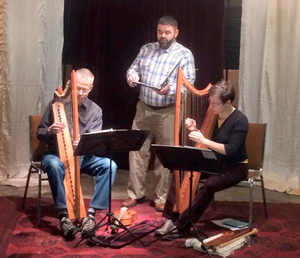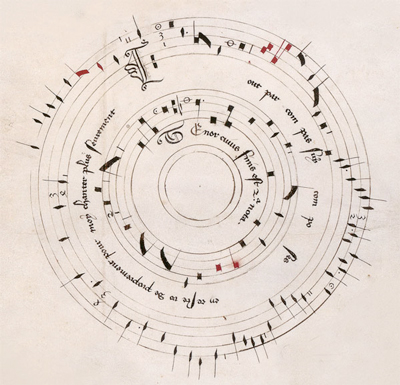by Daniel Hathaway

I heard the excellent, sold-out performance on Saturday evening at the William Busta Gallery in downtown Cleveland.
What led Les Délices to turn back four centuries from its customary French baroque repertory was the highly refined and rhythmically complex polyphonic music called Ars subtilior, often presented in the form of puzzles in such manuscripts as the Codex Chantilly, the Modena Codex and the Turin Manuscript. Music history graduate students have undoubtedly pulled out a lot of their hair trying to transcribe this music by Guillaume de Machaut, Jacob de Senleches, Baude Cordier, Johannes Ciconia, Pierre de Molins, Johannes Suzoy and the mysterious “Borlet,” whose name may itself be a puzzle that needs to be worked out. A number of pieces in this repertory are unsigned and remain unattributed.
Once you figure out the notes, these pieces are also fiercely difficult to perform, which made it all the more enjoyable to hear four expert musicians toss off fourteen of them on Saturday evening with such commendable ease, understanding and expressiveness. Les Délices founder and artistic director Debra Nagy represented the Cleveland-based ensemble, singing and playing recorders, doucaine and harp. Blue Heron director Scott Metcalfe played vielle and gothic harp, joined by countertenor Martin Near and tenor Jason McStoots.
Divided into five segments — Song as Object; Perfection in Nature; Courtly Love – Circles of Influence; Triumph of Reason – Music and Mathematics; and Carnal Pleasure – or, The Birds and the Bees — the hour-long program gave fascinating glimpses into a sophisticated musical world that treated its subjects with wit, humor and grace. And more than being merely historically intriguing, the music was lovely to listen to. The open intervals of an earlier era are still present, but melodies have become more lyrical and harmonies sweeter than before.
The program opened with McStoots singing the melody of Machaut’s palindromic chanson, Ma finest mon commencement, with Metcalfe and Nagy covering the other lines on agreeably buzzy harps (little resonating buttons vibrated by the strings provided the buzz). Nagy and Near beautifully matched their voices in Senleches’ La harpe de la melodie, and in Cordier’s Tout par compas (score above), with McStoots doubling Metcalfe’s tenor line.
For a change in instrumental color, Nagy took up the recorder and doucaine (a capped-reed instrument the English referred to as the “Still Shawm”) and Metcalfe the vielle or medieval fiddle, for Ciconia’s rhythmically contorted O rosa bella. Machaut’s Rose, lie (from the Roman de la Rose, “the textbook of courtly love,” as Metcalfe put it) wove the voices and instruments of all four musicians into a tapestry of alluring harmonies. Near’s clear, agile countertenor and McStoots’s resonant tenor (capable of contrasting colors in different registers) blended together beautifully.
Later in the program, Suzoy’s sendup of Pythagoras, Jubal and Orpheus, “the first fathers of melody,” put the supple voice of Martin Near through hoops of insanely ornate figuration. Afterward, Scott Metcalfe quipped, “It doesn’t get any weirder than that.”
The concert ended with music by the mysterious Borlet and the ubiquitous Anonymous. Ma tre dol rossignol and Je voy le bon temps, rhythmically bizarre but vocally splendid, first engaged all three singers, then the two men — plus vielle — in a jolly ending to a fascinating concert.
Les Délices and Blue Heron did the heavy lifting in this performance. All the audience had to do was enjoy the beautiful, musical swans skimming along on the surface of the water, blissfully unaware of what must have been some serious paddling going on below.
Watch a brief rehearsal video here.
Photo from a January 16 pop-up performance at the W. 78th Street Studios (L-R: Metcalfe, McStoots & Nagy).
Published on ClevelandClassical.com January 20, 2015.
Click here for a printable copy of this article




